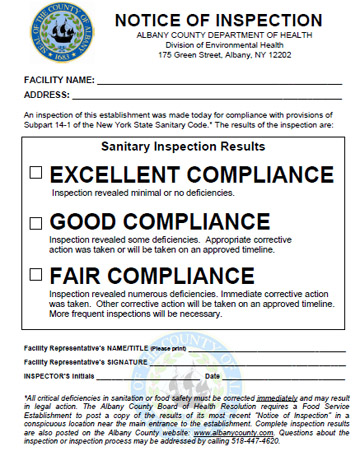City Council Speaker Christine Quinn on Friday voiced serious concerns about New York City’s restaurant inspection and grading system, calling for a series of oversight hearings for a process that she criticized as borderline harassment.
Michael Howard Saul of The Wall Street Journal explains that beginning in July 2010, in a high-profile move that drew the ire of the food industry but won kudos from diners, the Bloomberg administration began requiring restaurants to post cards with letter grades—A, B or C—reflecting the eatery’s performance on sanitary inspections conducted by the Department of Health and Mental Hygiene.
Ms. Quinn said she will authorize a series of oversight hearings on a variety of topics related to the inspection system, including whether the grading system is working and whether it has been .jpg) implemented fairly. The council will also examine whether food trucks and street carts should be required to post grades, mirroring what brick-and-mortar restaurants must do now.
implemented fairly. The council will also examine whether food trucks and street carts should be required to post grades, mirroring what brick-and-mortar restaurants must do now.
In a statement, Susan Craig, a spokeswoman for the Health Department, noted that surveys show 90% of New Yorkers approve of the grading and inspection program.
"We are delighted by its success. … "The program was not designed to be punitive. The program’s goal remains to provide New Yorkers with critical data when making their dining choices while encouraging restaurants to operate in the cleanest, safest way possible. Our hope is to see only A’s in restaurant windows."
Robert Bookman, an attorney representing hundreds of city restaurants, said, "Folks feel the Health Department is at war with the restaurant industry in the city of New York and that they see it as a cash cow. Bottom line, the grade system is built on a faulty point-system foundation that has only served to triple fines collected, while adding nothing to public food safety."
Mr. Bookman said the restaurant industry opposes the letter-grade system entirely. But if the city continues to keep using letter grades, he said, changes should be made.
Under the current system, if a restaurant does not receive an A, a second, unannounced inspection is conducted about a month later. But that inspection is completely new, and Mr. Bookman argued that it should instead be a re-inspection where the Health Department looks only to see if the problems identified on the first visit were fixed.
That lawyer needs better arguments. There’s lots of research out there about impact and effectiveness of restaurant disclosure systems. Horror stories of filthy restaurants in NYC are publicly available every week.

 title of franchise most often closed by health types.
title of franchise most often closed by health types. a recent survey by Baruch College at the City University of New York. It showed that 91 percent of New Yorkers approve of restaurant grading and 88 percent consider letter grades when dining, according to a telephone survey conducted in January and February.
a recent survey by Baruch College at the City University of New York. It showed that 91 percent of New Yorkers approve of restaurant grading and 88 percent consider letter grades when dining, according to a telephone survey conducted in January and February. about it – is a draw at best. Links to reductions in foodborne illness are speculation, bordering on false-hope.
about it – is a draw at best. Links to reductions in foodborne illness are speculation, bordering on false-hope..jpg) letter grading, the Council posted a questionnaire on its Web site (www.council.nyc.gov) asking the city’s 24,000 restaurateurs to share information about their experiences with inspectors and administrative tribunals, and the cost of fines and inspection consultants.
letter grading, the Council posted a questionnaire on its Web site (www.council.nyc.gov) asking the city’s 24,000 restaurateurs to share information about their experiences with inspectors and administrative tribunals, and the cost of fines and inspection consultants. consumers choose where to eat out or shop for food by giving them information about the hygiene standards in restaurants, cafés, takeaways, hotels and food shops.
consumers choose where to eat out or shop for food by giving them information about the hygiene standards in restaurants, cafés, takeaways, hotels and food shops. matrix takes into account the number of “blue” (minor) and “red” (serious) violations a restaurant receives.
matrix takes into account the number of “blue” (minor) and “red” (serious) violations a restaurant receives..jpg) chairwoman of the council’s Health Committee, which has maintained oversight of the health department.
chairwoman of the council’s Health Committee, which has maintained oversight of the health department..jpg) lot. You have people who throw up—they throw up a lot. … You see people cheating on their spouses, overhear bits of conversation. …
lot. You have people who throw up—they throw up a lot. … You see people cheating on their spouses, overhear bits of conversation. ….jpg) implemented fairly. The council will also examine whether food trucks and street carts should be required to post grades, mirroring what brick-and-mortar restaurants must do now.
implemented fairly. The council will also examine whether food trucks and street carts should be required to post grades, mirroring what brick-and-mortar restaurants must do now.